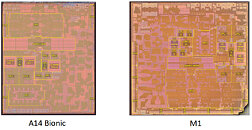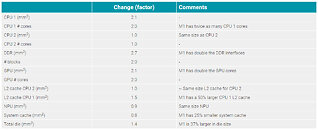Wednesday, December 30th 2020

Apple M1 & A14 Die Shot Comparison Shows Differences in SoC Design
When Apple first announced the M1, questions arose about the differences between it and the A14 chip which both share many architectural features and are both manufactured on TSMC's 5 nm process. Semiconductor analysis firm TechInsights has recently published die photos of the two processors and a summary of the changes.
The M1 features four high-performance Firestorm cores and four energy-efficient IceStorm cores for a total of eight CPU cores. The A14 only features six CPU cores with two high-performance Firestorm cores and four energy-efficient IceStorm cores. The M1 includes doubles the amount of GPU cores and DDR interfaces then found on the A14. The M1 also incorporates silicon not found on the A14 including the Apple T2 security processor and other controllers. These additions result in a die size 37% larger than the A14.
Source:
TechInsights
The M1 features four high-performance Firestorm cores and four energy-efficient IceStorm cores for a total of eight CPU cores. The A14 only features six CPU cores with two high-performance Firestorm cores and four energy-efficient IceStorm cores. The M1 includes doubles the amount of GPU cores and DDR interfaces then found on the A14. The M1 also incorporates silicon not found on the A14 including the Apple T2 security processor and other controllers. These additions result in a die size 37% larger than the A14.


16 Comments on Apple M1 & A14 Die Shot Comparison Shows Differences in SoC Design
i wanted an iPad Pro chip with double the GPU for the desktop (and maybe even GDDR6 memory)... or ever 4x the GPU, the GPU is much too slow for something that can't have expansion
One question from this (admittedly very high level overview): the big CPU cores look essentially identical. Does this mean that the reported in-silicon optimizations for X86 emulation are also there in the A14 lineup? That would make for some ... interesting possibilities if this hardware wasn't completely locked down. Emulated Windows 10 on an iPhone? :P
Here's Ivy Bridge, 8 years ago: www.anandtech.com/show/5771/the-intel-ivy-bridge-core-i7-3770k-review/3 (I know the CPU space looks bigger than M1's, but you have to consider Ivy Bridge doesn't have as many things integrated)For better or worse, Apple has this thing about selling one or two SKUs of everything (there are exceptions). Plus, they don't sell the CPU on its own. A few years down the road, I wouldn't be surprised if they sweep most CPU technical data under the rug and only advertise "Apple 2025 CPU/SoC".